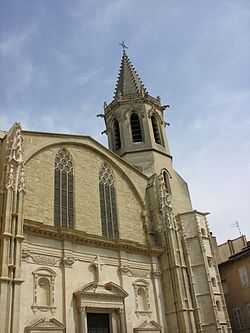Ancient Diocese of Carpentras
Carpentras was a residential diocese of the Catholic Church from an early date until 1801.
History
The first bishop of Carpentras historically documented is Constantinus, who was represented at the Council of Riez in 439. At a council held at Orléans in 541, Clemantius presented himself as Bishop of Carpentras and Venasque. Later 6th and 7th-century called themselves bishops of Venasque, with the exception of Boethius, who at Valence in 584 signed the acts of the council as Bishop of Carpentras. This suggests that, after Carpentras had fallen into ruin,[1] the bishops lived in nearby Venasque.[2][3][4][5]
At the beginning of the Avignon Papacy, Pope Clement V took up residence, with the Roman Curia, in Carpentras in 1313. It was his successor Pope John XXII who settled definitively at Avignon.
Carpentras was a suffragan see of Arles from 450 to 1475, when it became a suffragan of Avignon. Its cathedral was the Church of St. Siffrein, of Gothic origins with some Romanesque remains, which was reconstructed in the 15th century and dedicated in 1515.
In accordance with the Concordat of 1801, Carpentras ceased to be a residential diocese later that year, and its territory was incorporated into that of the Diocese of Avignon.[6]
In 1877, the title of bishop of Carpentras, along with those of other ancient sees, was added to that of the archbishops of Avignon and remained so until 2009. Since then Carpentras is listed by the Catholic Church as a titular see.[7]
Some individual bishops
The future Pope Julius II was made the Bishop of Carpentras when he was 17.[8]
Joseph-Dominique d'Inguimbert, Bishop of Carpentras from 1735 to 1754, established a great scholarly library which Jean-François Delmas, the current chief librarian, has called "the oldest of our municipal libraries"; known as the Bibliothèque Inguimbertine and now holding around 140,000 books, it is known to bibliophiles all over France and is scheduled to move into roomier quarters in the former Hôtel-Dieu in 2013.[9]
See also
References
- ↑ The early 5th-century Notitia Galliarum does not mention Carpentras among the cities of the area, an indication of its decay at the time; cf. Monumenta Germaniae Historica, Chronica minora, I, p. 559.
- ↑ Jules de Terris, Les Evêques de Carpentras. Etude historique, Avignon 1886
- ↑ Louis Duchesne, Fastes épiscopaux de l'ancienne Gaule, vol. I, Paris 1907, pp. 271–273
- ↑ Pius Bonifacius Gams, Series episcoporum Ecclesiae Catholicae, Leipzig 1931, pp. 529–530
- ↑ Konrad Eubel, Hierarchia Catholica Medii Aevi, vol. 1, pp. 167–168; vol. 2, p. 119; vol. 3, p. 154; vol. 4, p. 136; vol. 5, p. 144; vol. 6, p. 149
- ↑ Bull Qui Christi Domini, in Bullarii romani continuatio, Vol. XI, Roma 1845, pp. 245–249
- ↑ Annuario Pontificio 2013 (Libreria Editrice Vaticana 2013 ISBN 978-88-209-9070-1), p. 859
- ↑ Pope Julius II (Giuliano della Rovere) [Catholic-Hierarchy]
- ↑ Thomas Wieder, "Un cabinet de curiosités à Carpentras," Le Monde des Livres, August 13, 2009.
